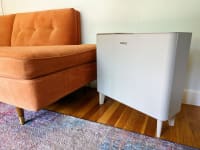Amazon's smart air monitor is awesome—here's why I love it
A fresh air quest, supported by Alexa Routines
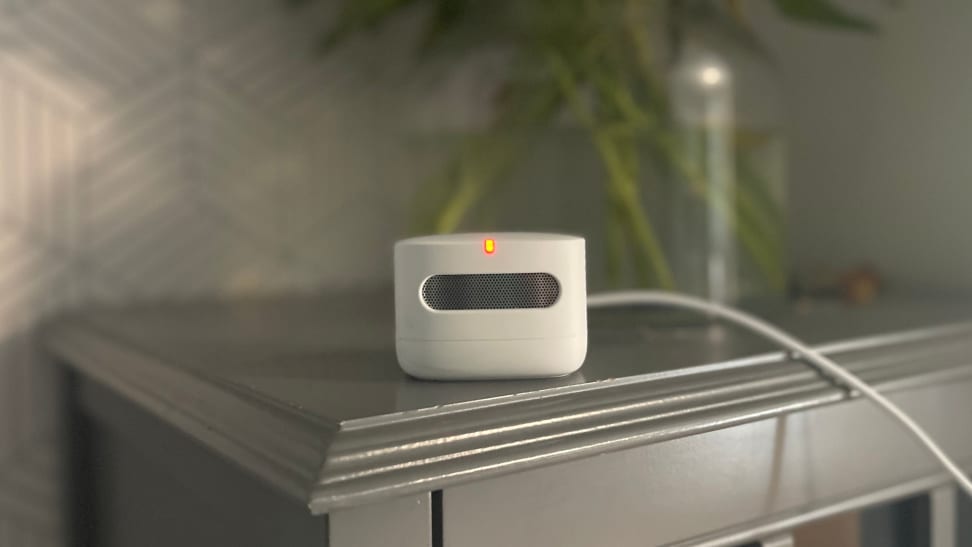 Credit:
Reviewed / Rachel Murphy
Credit:
Reviewed / Rachel Murphy
Products are chosen independently by our editors. Purchases made through our links may earn us a commission.
Many of us have become more aware of the air we breathe in public spaces over the last several years, but what about in the comfort of our own four walls? Poor indoor air quality can be hard to spot, but with a device like Amazon’s Smart Indoor Air Quality Monitor, you can get insights into the air you’re breathing at home.
The device, which works with Alexa, analyzes the atmosphere inside of your home by checking for common contributors to poor air quality like particulate matter (PM 2.5), volatile organic compounds, carbon monoxide, humidity, and temperature levels.
The readings are sent to the Amazon Alexa app, and Alexa herself can make announcements via Echo speakers and displays when poor air quality is detected, which in turn, may encourage you to turn on an air purifier to help improve your indoor air quality.
I’ve been testing the Amazon Smart Indoor Air Quality Monitor for several weeks at my home. Here’s what I think.
Buy the Amazon Smart Indoor Air Quality Monitor at Amazon
What we like
Indoor air quality insights are easy to understand
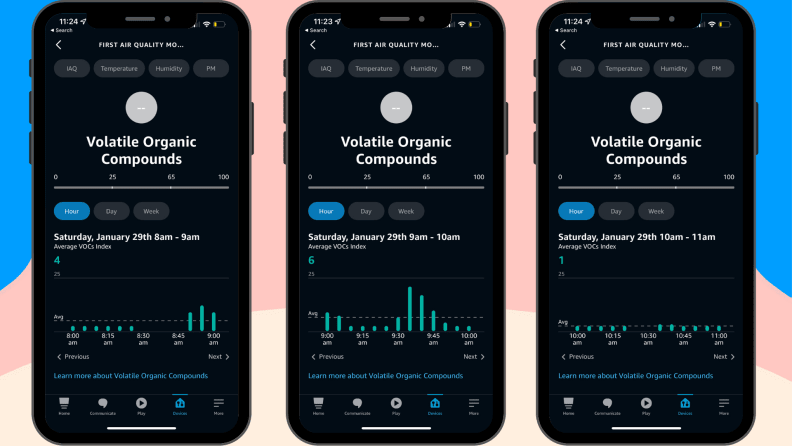
You can see an increase in VOCs when we start painting and a decrease once we are done.
The Amazon Alexa app, where you’ll set up and manage the monitor, provides a dashboard of details about your home’s air quality broken up into the five main categories the device is tracking for, as well as a general overview of the indoor air quality. Insights are provided on an hourly, daily, and weekly basis, allowing you to drill down into the data for a better understanding (and tips for creating cleaner air at home).
I mostly tested this monitor in my dining room (nearby my open concept kitchen). I noticed the biggest dips in air quality came while cooking, like using my electric oven and range top. During these instances, the air quality monitor tracked higher levels of particulate matter and humidity than before I started cooking, likely from a combination of steam, smoke, and food particles floating through the air. This prompted me to open the windows and set the range hood fan to a higher speed than I normally would—two ways that can help improve air quality.
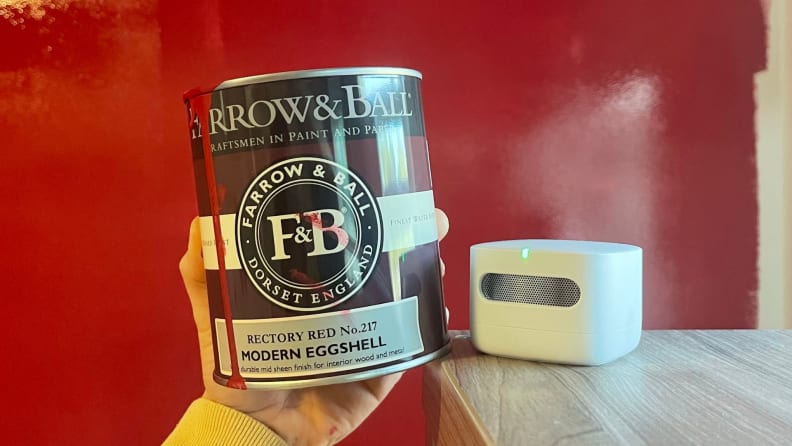
I tested the Amazon Smart Indoor Air Quality Monitor in my son's room for a day while painting with one of Farrow and Ball's low-VOC paints.
I also tested the monitor while using a paint with low volatile organic compounds (VOCs), to see what, if anything, it might track. Before painting, the chart shows a lower number of VOCs than before I started painting. The monitor tracked 24 VOCs toward the end of the painting session (still a safe amount), and tapered all the way off once we were done. I kept the window cracked for added ventilation during painting because this was done in my son's room (with his help).
Ultimately, the benefit to using the monitor is that it can bring awareness to a problem you may not know you had with your indoor air (like high levels of VOCs or increased humidity). The data from Amazon’s smart air quality monitor can be used to help you make more informed decisions about improving the air quality, like running an air purifier when a poor reading is detected.
Provides informative alerts for Alexa smart homes
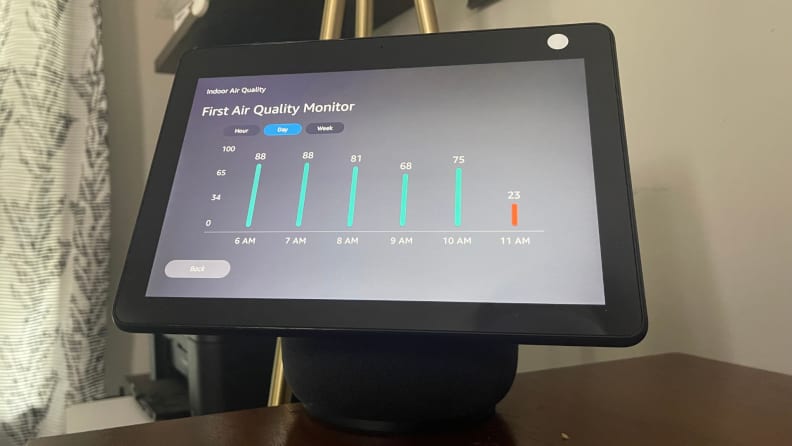
Amazon smart displays like the Echo Show 10 (pictured) provide visual insights about the Amazon Indoor Smart Air Quality Monitor.
The Amazon Smart Indoor Air Quality Monitor plays nicely with Alexa, the company’s wildly popular voice assistant. With an Amazon smart speaker like the fourth-gen Echo Dot, you can ask Alexa to give you the latest insights into your home’s indoor temperature, humidity, and air quality, and she’ll respond appropriately. For an even more informative experience, try asking those questions to an Amazon smart display like the Echo Show 10. Not only will Alexa answer your query, but she will also display color-coded insights on screen, which I prefer over the speaker-only response.
Alexa can also make announcements on your Echo devices when the indoor air quality is poor (but not when it’s improved). In the app, you can choose one or more speakers or displays to make the announcement when the air quality is questionable. I found this more helpful than glancing over at the device’s status light (it rotates between green, yellow, and red depending on the indoor air quality). The light’s visual cue is helpful, but for me, the announcements are the icing on the cake.
(Note that Alexa will only make these announcements between 7 a.m. and 10 p.m., which is probably not a big deal since most people are asleep, and you can still receive push notifications on your phone at all times.)
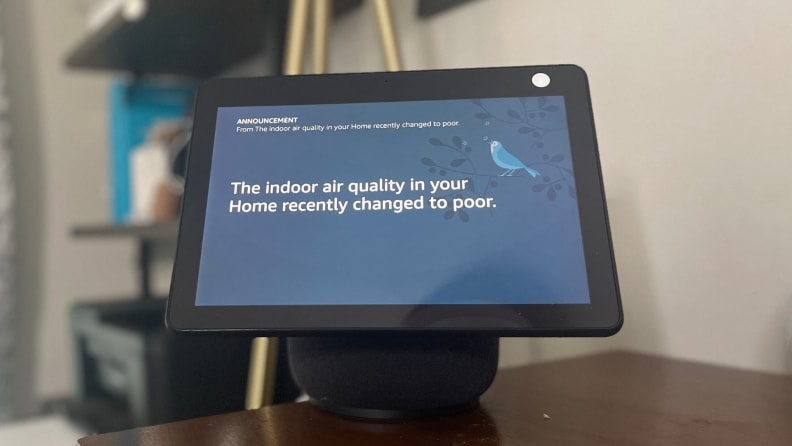
Alexa can make announcements on Echo speakers and Echo Show smart displays, like the Echo Show 10 (pictured), when the indoor air quality is poor.
You can use multiple Amazon air quality monitors in your home. Amazon recommends one per room (there is no square footage estimate). In the Alexa app, you can assign a specific name to each monitor. Alexa can tell you when the air quality in, say, the bedroom is poor (you can ask her for the status of a particular room, too).
It (finally) works with Alexa Routines
When the Amazon Smart Air Quality Monitor debuted, it (mostly) lacked the functionality that makes it compatible with Alexa Routines. At the time, it only supported temperature-triggered routines, which weren’t as helpful when it comes to cleaning the air in your home.
Since publishing my review, Amazon has improved the monitor to support Alexa Routines. Huzzah! I’ve been testing the new feature for the last several weeks and it works great.
You can set your air purifier to trigger on via a compatible smart plug when the Amazon Smart Air Quality Monitor detects a change in carbon monoxide levels, indoor air quality, temperature, particulate matter, volatile organic compounds, or indoor humidity. When creating the routine, you can set the threshold for when the routine kicks on. For example, you can set the air purifier to turn on when the indoor air quality level goes above, say, 51. (A value of 50 or lower is considered good.)
Home automation features like Alexa Routines make life easier—and can help keep the air clean inside of my home without much effort for me.
What we don’t like
There’s no standalone app
The Amazon Smart Indoor Quality Monitor is buried in the Alexa app (the main way to manage the device), making it hard to find if you aren't accustomed to the app already. Ultimately, the Alexa app has too much going on for me when it comes to daily smart home device management. This is one area where having a standalone Amazon Devices app could be beneficial (similar to how Google Assistant and Google Home operate together but from two different apps).
Also, if you have a lot of devices connected to Alexa, you will likely find it as annoying as I did to scroll through a list of 50-plus smart home gadgets trying to locate the air quality monitor. Typically, you can remedy this by adding the accessory to your Favorites list in the Devices section of the app, which is much easier than any amount of scrolling. Unfortunately, the monitor can’t be added here, making it cumbersome to manage on the go.
Additionally, during setup, the device appears in the Alexa app as the “First Air Quality Monitor.” I found this a bit confusing, as the name is slightly different from the Amazon product page. You can change the name in the device’s settings to something that’s easier to remember like “Living Room Air Quality Monitor,” especially before setting up a second monitor to prevent any confusion. Hopefully, this tip will save you some headaches.
Constant power is required
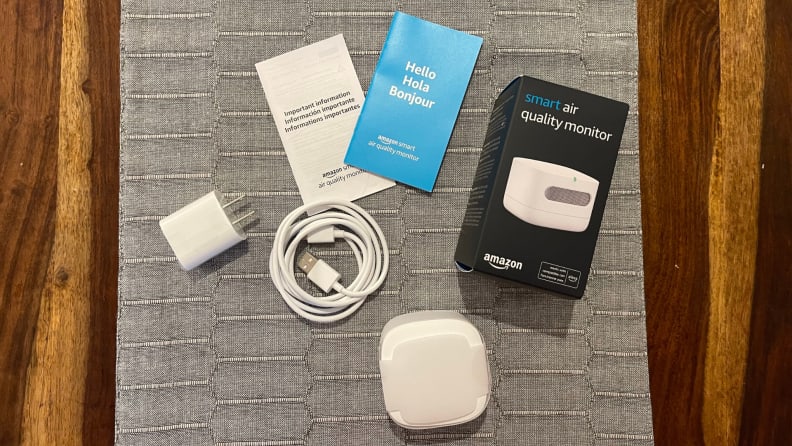
The Amazon Smart Indoor Air Quality Monitor comes with a micro USB cable and plug and must be tethered to an outlet at all time to get power.
The Amazon Smart Indoor Air Quality Monitor gets power using a micro USB cable via a standard electrical outlet. The cord is about five feet long, which was enough for me to place it on a cabinet in my dining room. From a placement perspective, I’d prefer the monitor to be rechargeable via a micro USB-C cable. Or at least to run on batteries, like Amazon’s spread of Ring Alarm sensors (some of which can track similar stats like moisture, carbon monoxide, and temperature levels).
Ditching the cord would make it easier to place the monitor anywhere in your home—not just near an outlet. It’s a small gripe, but something to consider, especially if you live in an older home without as many outlets as a new build (or recently rewired home).
You want to avoid unplugging it as much as possible, so you don’t disrupt the data collection. Each time you unplug it and plug it back in, the monitor takes a couple of minutes to recalibrate before it starts tracking the air quality again.
Should you buy the Amazon Smart Indoor Air Quality Monitor?
Yes, this air quality monitor works well.
Yes, the addition of Alexa Routines gives the Amazon Smart Indoor Air Quality Monitor the smarts it needs to be a functional and useful device. The audible Alexa alerts are helpful, too, to keep me in the know about the air quality in my home. The device has a couple of usability quirks (I wish there was a more convenient way to manage the monitor and access the insights). But overall, it provides a high level of detail about your indoor quality with features, like Alexa Routines, that can be used to cleanse the air automatically.

